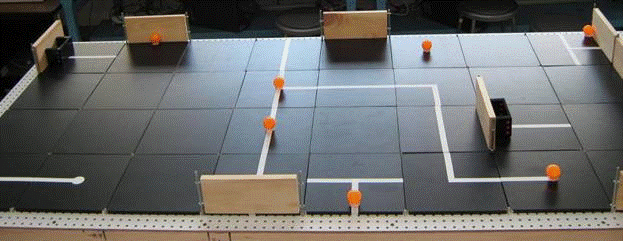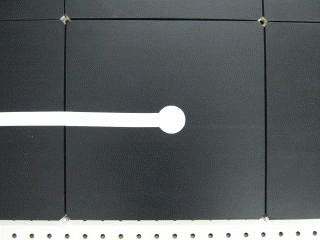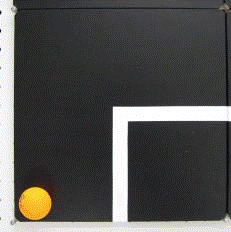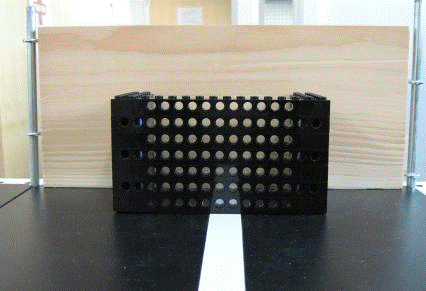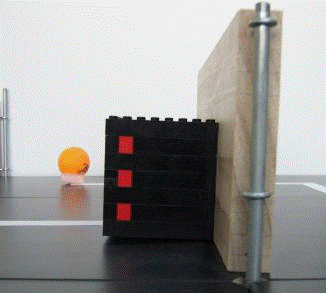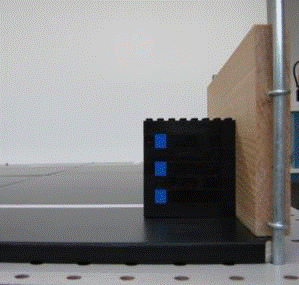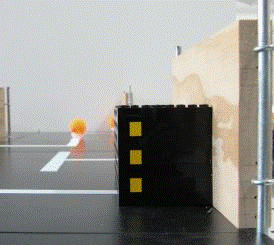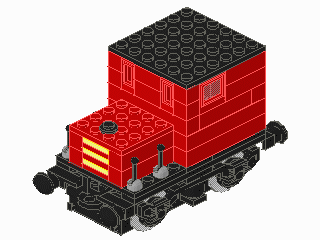Retrieval and Delivery System (RDS)
RFP*: Modular Retrieval and Delivery System (MRDS)
* RFP is an acronym for Request For Proposal. Internationally, RFPs are called ITTs, an acronym for Invitation To Tender. Companies and governmental agencies use RFPs to solicit new business.
INTRODUCTION AND OVERVIEW
A blackout has occurred in the Northeast United States. In the city of New York, three hospitals have used up their backup power supplies due to the unanticipated duration of the blackout. There are some power supply areas in the city with fuel cells that supply enough power for the hospitals’ need. In order to save lives, Mayor Michael Bloomberg has issued an RFP for a robot that can retrieve and deliver fuel cells accumulating a minimum of 120 hours of reserve energy.
Figure 1: New York City navigation field
Note: The picture above contains one representation of this project description.
Actual course may be different from the one pictured above, but similar in objective.
SPECIFICATIONS
Design a robot using MLCad as your primary design tool. Your team must build a model of your design using the materials provided. A Mindstorms program that will direct the robot's movements must be created. A cost estimate of the robot's components must be provided. All revisions to the original design must be recorded and explained. This includes technical design drawings, as well as cost estimates. All revisions to the Mindstorms program must be recorded and explained.
The MRDS must be able to navigate autonomously around the city and retrieve fuel cells and deliver them to the hospitals. Note that these hospital positions may change each semester! The robot must accumulate a total of 120 hours of reserve energy in less than five minutes. The robot's footprint (length and width) may not be larger than 28cm x 28cm.
The robot program may not be altered or switched during any part of the mission. Likewise, the robot must be fully autonomous, and therefore cannot be touched by any person during testing. These specifications must be met for final commissioning. Please refer to the course syllabus for all due dates.
MRDS COURSE DESCRIPTION
Your robot starts on a tile indicated like this:
Figure 2: Starting location
Note: The picture above contains one representation of this project description.
Actual course may be different from the one pictured above, but similar in objective.
The back of the robot must be facing the side of the tile that is on the outside border of the course.
Each power supply area has different amounts of hours their fuel cell can supply.
Figure 3: Example of a fuel cell
Note: The picture above contains one representation of this project description.
Actual course may be different from the one pictured above, but similar in objective.
For example, power supply areas located in the middle of a tile have fuel cells with 25 hours of battery life.
Figure 4: Location of 25-hour fuel cell
Note: The picture above contains one representation of this project description.
Actual course may be different from the one pictured above, but similar in objective.
Power supply areas located on the sides of a tile have fuel cells that can supply 30 hours of battery life.
Figure 5: Location of 30-hour fuel cell
Note: The picture above contains one representation of this project description.
Actual course may be different from the one pictured above, but similar in objective.
Power supply areas located on the corners of a tile have fuel cells that can supply 35 hours of battery life.
Figure 6: Location of 35-hour fuel cell
Note: The picture above contains one representation of this project description.
Actual course may be different from the one pictured above, but similar in objective.
Each hospital has a different level of energy consumption. The colors of the sides of each hospital show the power efficiency of the hospital.
Figure 7: A hospital
Note: The picture above contains one representation of this project description.
Actual course may be different from the one pictured above, but similar in objective.
A hospital color-coded in red uses the energy three times as efficiently as the standard hospital, thereby extending the battery life of a fuel cell to three times its standard battery life.
Figure 8: Red hospital
Note: The picture above contains one representation of this project description.
Actual course may be different from the one pictured above, but similar in objective.
A hospital color-coded in blue uses the energy twice as efficiently as the standard hospital, thereby extending the battery life of a fuel cell to twice its standard battery life.
Figure 9: Blue hospital
Note: The picture above contains one representation of this project description.
Actual course may be different from the one pictured above, but similar in objective.
A hospital color-coded in yellow represents the standard hospital, and therefore fuel cells used at this hospital will retain its standard battery life.
Figure 10: Yellow hospital
Note: The picture above contains one representation of this project description.
Actual course may be different from the one pictured above, but similar in objective.
HOUR TOTALS
By successfully returning the retrieved fuel cells to one of the hospitals, the fuel cell’s battery life is multiplied by the hospital’s efficiency.
For example, if the robot retrieved a 25-hour fuel cell and successfully placed it in the red hospital, the robot would successfully receive 75 hours for that fuel cell (25 x 3 = 75). The yellow hospital is assigned an efficiency of 1, the blue hospital is assigned an efficiency of 2, and the red hospital is assigned an efficiency of 3.
Please Note:
Creativity and innovation are always rewarded. Original designs will receive extra credit.
MICROSOFT PROJECT
Your team must create a time management plan using Microsoft Project (MS Project). You can learn Microsoft Project by doing the MS Project Skill Builder contained elsewhere in this manual. This plan must include all tasks related to the project. Each task must be named, assigned a duration and assigned to a specific person (or people). You must begin your work by creating an MS Project plan. Follow your project plan throughout the semester. If the team falls behind schedule, explain the reasons for the delays when you present your progress reports, list the steps being taken to get the project back on track, and create a revised MS Project plan.
For help in planning your project, review the page called How to plan the schedule and calculate costs for a project in the section called Material to help you with the project elsewhere in this manual.
There should be at least twenty tasks/subtasks and three Milestones. Milestones should be noted with the duration of "0day". Moreover, the copy picture function included in MS Project Software should be used instead of the print screen function of the computer.
DRAWINGS
A command of MLCad is necessary for you to complete the drawings required for this project. Use MLCad to create four drawings of your robot: front, top, most detailed side, and a drawing of your gear trains. Sensors, motors, and gears must be included in each drawing. All parts used in the robot must be referred to using the part number found in the price list.
Each revision of your design must be documented. This is done by saving the old side view drawing, and assigning a revision number to the new drawing.
Figure 3: Sample isometric image from MLCad (without part numbers)
MODEL
You must build a scale model (1:1) of your design. The following materials will be provided:
- Mindstorms kit
- One NXT
- Sensors
- Motors
Additional materials can be supplied by your TA.
COST ESTIMATE
Once a robot design is complete, a cost estimate must be generated that specifies the cost of all the materials and labor required for the construction of your design. Tabulate this cost information clearly in an Excel spreadsheet, using the materials cost list provided. You can get help in calculating the cost by reviewing the page called How to plan the schedule and calculate costs for a project in the section called Material to help you with the project elsewhere in this manual. The costs for the parts can be found on the page Price list for Lego parts for robot projects in the Material to help you with the prject section elsewhere in this manual.
Note: You should only use the materials contained in the Price list for Lego parts for robot projects. If you want to use other parts, get permission from your faculty member to do so, and also to determine the cost of the parts you want to use that are not in this price list.
Have all the materials and parts used categorized in different groups instead of including individual parts. Make sure to include the units of each part used in a group and total them up for that individual group. Moreover, the cost of labor should be included. You can get help on the labor cost by reading the page How to plan the schedule and calculate costs for a project in the section called Material to help you with the project elsewhere in this manual.
MILESTONES
As you work on your project, you will be required to present periodic reports on your progress. We call these Milestones. All the items assigned in each Milestone are called deliverables. These deliverables often consist of a combination of written submissions, presentations, and demonstrations.
Milestone 1
Prepare a preliminary sketch of your design, a cost estimate, and an MS Project plan.
Look Ahead: What tasks do you plan between now and Milestone 2?
Milestone 1 Deliverables: A presentation. Include the preliminary sketch, cost estimate, and MS Project plan. Include a brief description of the robot and any special features and benefits of your design.
Note: Whenever you revise your drawing(s), your cost estimate, or your MS Project plan, you must include the initial drawing, the initial cost estimate, or the initial MS Project plan, in addition to the revision.
Milestone 2
Using MLCad, prepare four views of your latest design: front, top, most detailed side, and an isometric drawing. Create an MLCad drawing of your gear trains. Complete your latest Mindstorms program and your latest MS Project plan reflecting any schedule changes. Finally, calculate a revised cost estimate. A signed Component Testing Form must be submitted to your Recitation TA.
Look Ahead: What tasks do you plan between now and Milestone 3?
Milestone 2 Deliverables: A copy of your presentation slides that includes four views of your design using MLCad: front, top, most detailed side, and an isometric drawing; an MLCad drawing of your gear trains; your Mindstorms program; a revised cost estimate; your revised MS Project plan; and your signed Component Testing Form.
Note: Whenever you revise your drawing(s), your cost estimate, or your MS Project plan, you must include the initial drawing, the initial cost estimate, or the initial MS Project plan, in addition to the revision.
Milestone 3
Using MLCad, prepare four views of your latest design: front, top, most detailed side, and an isometric drawing. Create an MLCad drawing of your gear trains. Complete your latest Mindstorms program and your latest MS Project plan reflecting any schedule changes. Finally, calculate a revised cost estimate.
Look ahead: What tasks do you plan between now and the completion of the project?
Milestone 3 Deliverables: A copy of your presentation slides that includes four views of your design using MLCad: front, top, most detailed side, and an isometric drawing; an MLCad drawing of your gear trains; your Mindstorms program; a revised cost estimate; and your revised MS Project plan.
Note: Whenever you revise your drawing(s), your cost estimate, or your MS Project plan, you must include the initial drawing, the initial cost estimate, or the initial MS Project plan, in addition to the revision.
FINAL PRESENTATION
The exact specifications for your final presentation will be provided by your instructor. Some of these requirements will be: the features and benefits of your design, project specifications, all drawings, Mindstorms programs, cost estimates, and your completed MS Project. After you deliver your final presentation, you will proceed to the Model Shop to have your work commissioned (tested). A signed Commissioning Statement must be included with your final presentation materials.
Final Submission
Your project should be submitted as a folder containing the following deliverables:
- Component testing statement
- Commissioning statement
- Hardcopy and CD containing:
- Final presentation
- Cover page and table of appendices.
- Appendices:
- Final Mindstorms program
- Initial sketch
- All the drawings of your final design
- Video
- Final MS Project Schedule
- Final Cost estimate
- Resume(s)
EARLY ACCEPTANCE
If you complete your project one week early, you are eligible for a bonus that will be added to your final semester-long project grade. You must submit all deliverables by 5PM one week before your section is scheduled to present (see syllabus for exact date). To commission early, all required information on the form titled Project Submission Form, found on the EG web site, must be approved, accepted, and signed by a TA. The deliverables received early are the ones you will use in your presentation. No adjustments to the deliverables commissioned will be accepted.
LIQUIDATED DAMAGES
If you do not complete all your deliverables and do not commission during the Final Presentation, you will incur liquidated damages as defined in the grading policy.
